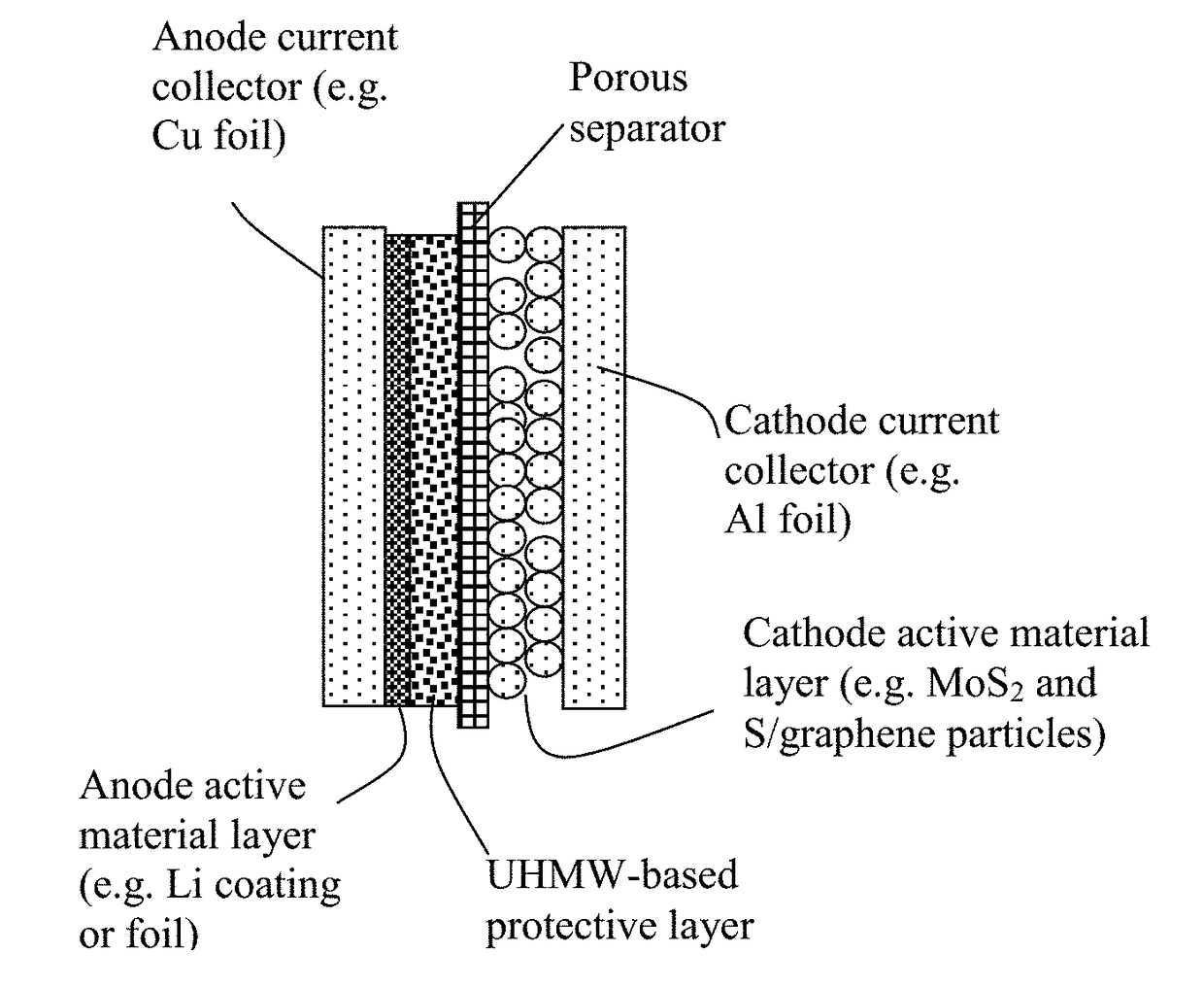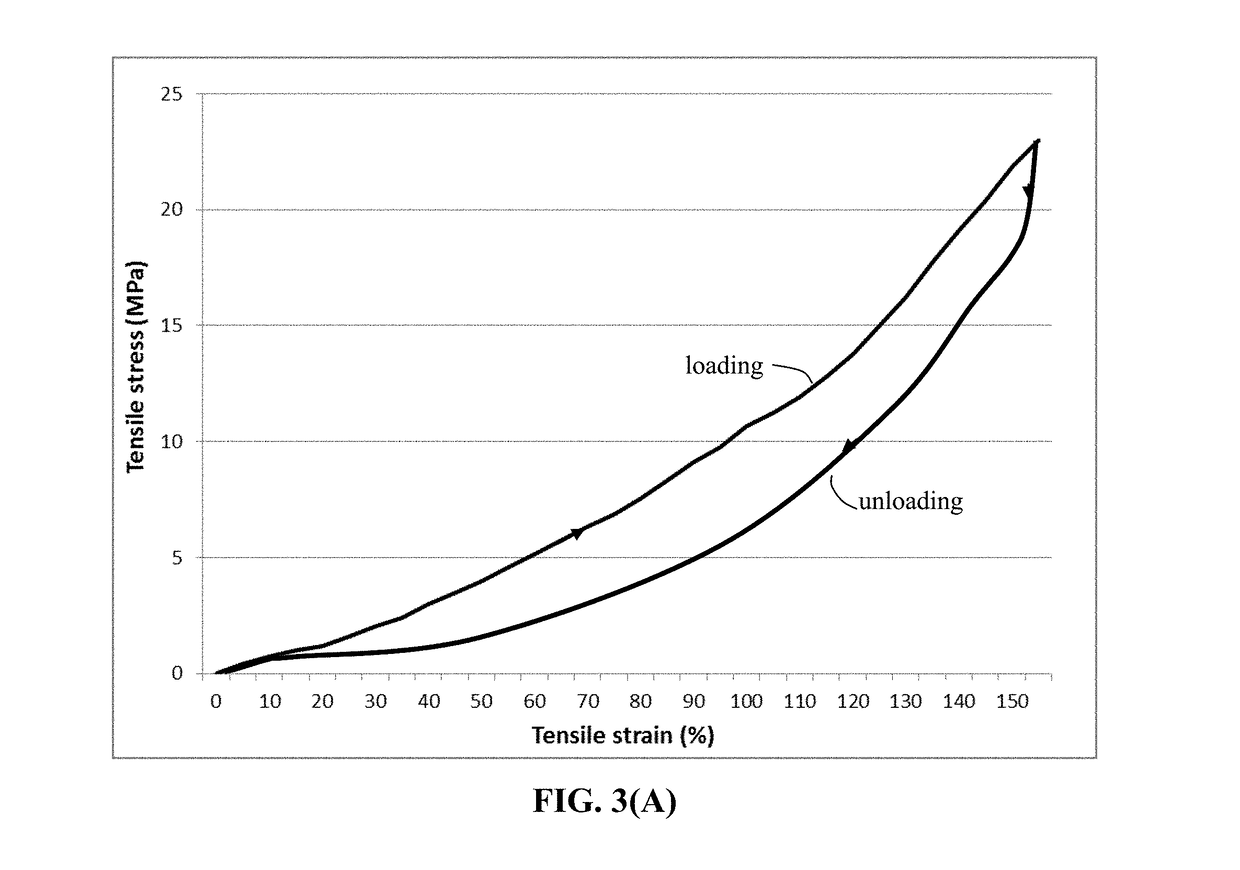Lithium Metal Secondary Battery Containing an Anode-Protecting Polymer Layer and Manufacturing Method
a polymer layer and secondary battery technology, applied in the direction of cell components, final product manufacturing, sustainable manufacturing/processing, etc., can solve the problem of re-deposition of lithium ions back to the current collector, and achieve the effect of improving the conductivity of lithium ions to a polymer
- Summary
- Abstract
- Description
- Claims
- Application Information
AI Technical Summary
Benefits of technology
Problems solved by technology
Method used
Image
Examples
example 3
Cells Containing Metal Fluoride Nano Particle-Based Cathode and an UHMW PPO-Protected Lithium Anode
[0104]For protection of the lithium anode, an UHMW PPO polymer was implemented as a thin protective layer by using a procedure similar to that described in Example 1. Commercially available powders of CoF3, MnF3, FeF3, VF3, VOF3, TiF3, and BiF3 were subjected to high-intensity ball-milling to reduce the particle size down to approximately 0.5-2.3 μm. Each type of these metal fluoride particles, along with graphene sheets (as a conductive additive), was then added into an NMP and PVDF binder suspension to form a multiple-component slurry. The slurry was then slurry-coated on Al foil to form cathode layers.
[0105]Shown in FIG. 5 are the discharge capacity curves of two coin cells having the same cathode active material (FeF3), but one cell having a high-elasticity UHMW PPO polymer-protected anode and the other having no protective layer. These results have clearly demonstrated that the hi...
example 4
c Cell Containing a Metal Naphthalocyanine / Reduced Graphene Oxide (FePc / RGO) Hybrid Particulate Cathode and a UHMW PAN-Protected Li Foil Anode
[0107]Particles of combined FePc / graphene sheets were obtained by ball-milling a mixture of FePc and RGO in a milling chamber for 30 minutes. The resulting FePc / RGO mixture particles were potato-like in shape. Some of these mixture particles were encapsulated by a high-elasticity UHMW PAN polymer using the pan-coating procedure. Two lithium cells were prepared, each containing a Li foil anode, a porous separator, and a cathode layer of FePc / RGO particles (encapsulated or un-encapsulated).
[0108]The cycling behaviors of these 2 lithium cells are shown in FIG. 6, which indicates that the lithium-organic cell having a high-elasticity polymer protection layer in the anode exhibits a significantly more stable cycling response. This protective polymer reduces or eliminates the continuing contact between the lithium metal and the electrolyte, yet the ...
example 5
s Containing an Anode-Protecting Layer and a Cathode Containing Sulfur-Impregnated Activated Carbon Particles
[0109]One way to combine sulfur with a conducting material (e.g. carbon / graphite particles) is to use a solution or melt mixing process. Highly porous activated carbon particles, chemically etched meso-carbon micro-balls (activated MCMBs), and exfoliated graphite worms were mixed with sulfur melt at 117-120° C. (slightly above the melting point of S, 115.2° C.) for 10-60 minutes to obtain sulfur-impregnated carbon particles.
[0110]FIG. 7 shows the cathode specific capacity values of two Li—S batteries having a cathode active material based on a S-impregnated activated MCMB: one cell having an UHMW PEO-protected anode and the other one having no anode protection layer. The highly beneficial effect of an UHMW polymer layer implemented at the anode is very significant.
PUM
 Login to View More
Login to View More Abstract
Description
Claims
Application Information
 Login to View More
Login to View More - R&D
- Intellectual Property
- Life Sciences
- Materials
- Tech Scout
- Unparalleled Data Quality
- Higher Quality Content
- 60% Fewer Hallucinations
Browse by: Latest US Patents, China's latest patents, Technical Efficacy Thesaurus, Application Domain, Technology Topic, Popular Technical Reports.
© 2025 PatSnap. All rights reserved.Legal|Privacy policy|Modern Slavery Act Transparency Statement|Sitemap|About US| Contact US: help@patsnap.com



